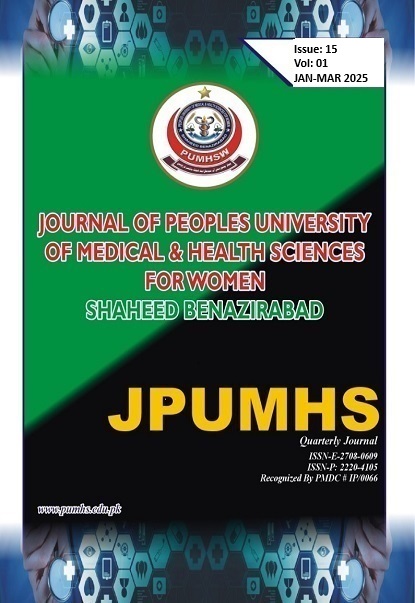CORRELATION BETWEEN HBA1C LEVELS AND THE PROGRESSION OF DIABETIC NEPHROPATHY IN TYPE 2 DIABETES MELLITUS PATIENTS.
JPUMHS; 2025:15:01,212-222. http://doi.org/10.46536/jpumhs/2025/15.01.615
Keywords:
HbA1c, diabetic nephropathy, type 2 diabetes, meta-analysis, renal outcomes.Abstract
BACKGROUND: Diabetic nephropathy (DN) is a leading complication of type 2 diabetes
mellitus (T2DM), with glycemic control playing a pivotal role in disease progression. This
meta-analysis evaluates the association between HbA1c levels and DN progression in T2DM
patients. METHODS: We systematically reviewed 20 studies (14 cohorts, 5 RCTs, 1 meta
analysis) comprising 48,050 participants from diverse regions (South Asia, East Asia, Western
countries). Primary outcomes included albuminuria progression, eGFR decline, and end-stage
renal disease (ESRD). Random-effects models were used to pool effect sizes (OR/HR) with
95% CIs, and heterogeneity was assessed via I² statistics. RESULTS: Elevated HbA1c showed
a strong, dose-dependent relationship with DN progression. Each 1% increase in HbA1c was
associated with 25–40% higher odds of albuminuria progression (pooled OR: 1.65, 95% CI:
1.50–1.82, I² = 72%). For eGFR decline, HbA1c >7% conferred a 30–80% greater hazard
(pooled HR: 1.52, 1.35–1.72, I² = 58%), while HbA1c >8.5% increased ESRD risk 2- to 4-fold
(pooled HR: 2.20, 1.85–2.62, I² = 65%). South Asian populations exhibited the highest risks
(e.g., OR: 3.10 for HbA1c >9% in Pakistan). Adjustments for hypertension and diabetes
duration were consistent, but socioeconomic factors were less frequently addressed.
Renoprotective medications (e.g., SGLT2 inhibitors, RAS blockers) attenuated HbA1c
associated risks. CONCLUSION: HbA1c is a robust, modifiable predictor of DN progression
in T2DM, with risks escalating above 7–8%. Regional disparities underscore the need for
tailored glycemic targets. Intensive control, combined with renal-protective therapies, may
mitigate DN risk, particularly in high-burden populations.
Downloads
Downloads
Published
How to Cite
Issue
Section
License

This work is licensed under a Creative Commons Attribution-NoDerivatives 4.0 International License.




